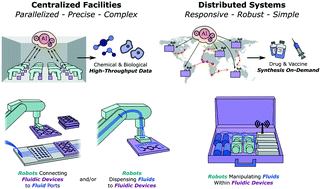Our official English website, www.x-mol.net, welcomes your
feedback! (Note: you will need to create a separate account there.)
When robotics met fluidics.
Lab on a Chip ( IF 6.1 ) Pub Date : 2020-01-02 , DOI: 10.1039/c9lc01042d Junjie Zhong 1 , Jason Riordon 1 , Tony C Wu 2 , Harrison Edwards 3 , Aaron R Wheeler 4 , Keith Pardee 5 , Alán Aspuru-Guzik 2 , David Sinton 1
Lab on a Chip ( IF 6.1 ) Pub Date : 2020-01-02 , DOI: 10.1039/c9lc01042d Junjie Zhong 1 , Jason Riordon 1 , Tony C Wu 2 , Harrison Edwards 3 , Aaron R Wheeler 4 , Keith Pardee 5 , Alán Aspuru-Guzik 2 , David Sinton 1
Affiliation

|
High-throughput fluidic technologies have increased the speed and accuracy of fluid processing to the extent that unlocking further gains will require replacing the human operator with a robotic counterpart. Recent advances in chemistry and biology, such as gene editing, have further exacerbated the need for smart, high-throughput experimentation. A growing number of innovations at the intersection of robotics and fluidics illustrate the tremendous opportunity in achieving fully self-driving fluid systems. We envision that the fields of synthetic chemistry and synthetic biology will be the first beneficiaries of AI-directed robotic and fluidic systems, and largely fall within two modalities: complex integrated centralized facilities that produce data, and distributed systems that synthesize products and conduct disease surveillance.
中文翻译:

当机器人技术遇到流体技术时。
高通量的流体技术提高了流体处理的速度和准确性,以至于无法释放更多的收益,就需要用机械手代替人工操作员。化学和生物学的最新进展,例如基因编辑,进一步加剧了对智能,高通量实验的需求。机器人技术与流体技术的交汇处越来越多的创新,说明了实现完全自动驾驶流体系统的巨大机会。我们设想,合成化学和合成生物学领域将是AI导向的机器人和流体系统的首批受益者,并且主要属于两种模式:产生数据的复杂的集成集中式设施以及用于合成产品并进行疾病监测的分布式系统。
更新日期:2020-02-19
中文翻译:

当机器人技术遇到流体技术时。
高通量的流体技术提高了流体处理的速度和准确性,以至于无法释放更多的收益,就需要用机械手代替人工操作员。化学和生物学的最新进展,例如基因编辑,进一步加剧了对智能,高通量实验的需求。机器人技术与流体技术的交汇处越来越多的创新,说明了实现完全自动驾驶流体系统的巨大机会。我们设想,合成化学和合成生物学领域将是AI导向的机器人和流体系统的首批受益者,并且主要属于两种模式:产生数据的复杂的集成集中式设施以及用于合成产品并进行疾病监测的分布式系统。











































 京公网安备 11010802027423号
京公网安备 11010802027423号